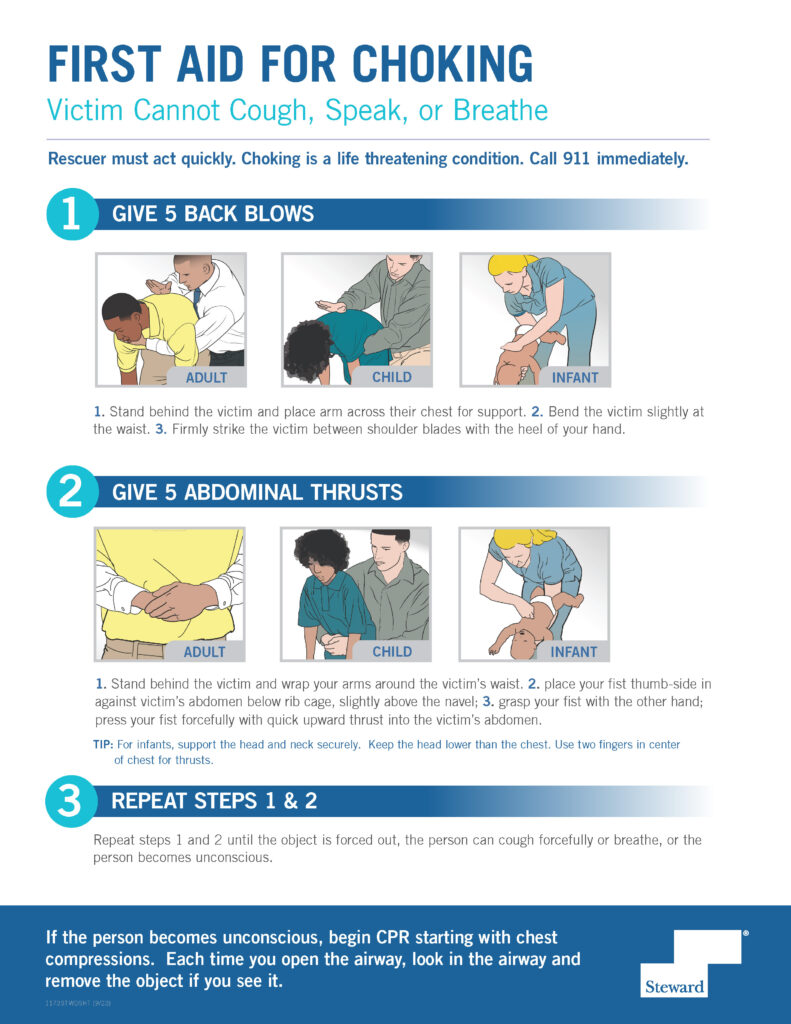 Choking is a terrifying and potentially life-threatening situation that can happen to anyone, anywhere. Knowing what action to take when someone is experiencing a choking incident can mean the difference between life and death. According to the National Safety Council, foreign-body airway obstruction (FBAO), also known as choking, is the fourth leading cause of unintentional death in the United States. Steward sat down with Robert Ford, DO, to discuss the causes, risks, actions to take, misconceptions, and available resources to better assist if someone is choking.
Choking is a terrifying and potentially life-threatening situation that can happen to anyone, anywhere. Knowing what action to take when someone is experiencing a choking incident can mean the difference between life and death. According to the National Safety Council, foreign-body airway obstruction (FBAO), also known as choking, is the fourth leading cause of unintentional death in the United States. Steward sat down with Robert Ford, DO, to discuss the causes, risks, actions to take, misconceptions, and available resources to better assist if someone is choking.
A graduate of Purdue University and the West Virginia School of Osteopathic Medicine, Dr. Ford is board-certified in Emergency Medicine, and serves as the Emergency Department Medical Director and Chair of Emergency Medicine at Rockledge Regional Medical Center in Rockledge, Florida. Dr. Ford has a long-standing interest in working as an EMS physician, having worked as an EMT, flight physician, and EMS mobile physician. He is also is the EMS Medical Director for multiple agencies.
What are the Most Common Causes of Choking?
Choking can occur when a foreign object becomes lodged in the throat or windpipe, blocking the flow of air. Common culprits include:
- Food: Large, poorly chewed, or hard pieces of food are common choking hazards, especially when eating is rushed or not supervised.
- Small Objects: Non-food items like coins, buttons, batteries, toys, and small parts of objects can pose a choking risk, especially for toddlers who explore by placing objects in their mouths.
- Medical Conditions: Certain medical conditions may affect the ability to chew or swallow. This may be the result of reduced mobility due to age, an accident, a stroke, or neuromuscular disorders.
Who is Most at Risk of Choking?
Choking can affect individuals of all ages, but certain populations may be more susceptible. High-risk groups include:
- Adults: The elderly and those with swallowing difficulties due to medical conditions like stroke or neuromuscular disorders are at an increased risk of choking incidents.
- Toddlers: As a natural part of their exploration and development, children under the age of five often place objects in their mouths, which increases their risk of choking.
What are the Necessary Actions to Assist Choking Victims?
Reacting swiftly and appropriately can be the difference between life and death. When every second counts, here are steps to take if you encounter someone who is choking:
- Assess the situation: Quickly determine if the person is indeed choking. They may have difficulty breathing, speaking, or coughing, or they may be unconscious.
- Encourage Coughing: If the person is coughing forcefully, encourage them to keep coughing to try and dislodge the object. For infants, check if the object is visible and use your fingers to remove the object.
- Perform the Heimlich Maneuver (Abdominal Thrusts):
- For Adults: Stand behind the person, place your arms around their waist, and make a fist just above the navel. Grasp your fist with the other hand and give quick upward thrusts.
- For Infants: Use a modified technique by holding the child in one arm or across your lap with the head tilted downward. Firmly tap the back between the shoulder blades with the heel of your hand. Turn the infant around and perform abdominal thrusts by using two fingers in the center of the chest for thrusts.
- Back Blows and Chest Thrusts: If the Heimlich maneuver isn’t effective, alternate between back blows and chest thrusts.
- Perform CPR and Dial 911: If the person can’t breathe, loses consciousness, or the obstruction isn’t cleared, have someone call emergency services immediately while you administer CPR.
*For an infant who swallows a button battery, administer honey every five minutes. The acid in the battery is caustic to the tissues. Keep batteries away from children.
What are Useful Tips to Reduce Choking Incidents?
Prevention is key to reducing the probability of choking. Caregivers should take these steps when caring for elderly family members or toddlers:
- Cut Food into Small Pieces: Cut food into smaller pieces and encourage eating slowly and chewing food properly.
- Supervise Meals and Playtime: Pay close attention while they’re eating to ensure they don’t swallow food too quickly. Always supervise young children while they are playing with small objects.
- Scan Your Environment: Scan the floors for hazards such as coins, button batteries, and other inorganic substances.
What are Some Common Misconceptions About Choking?
Some misconceptions around choking and providing aid are:
- Drinking water alone can dislodge a stuck object.
- Water might not be forceful enough to remove an obstruction. Use proper techniques, like the Heimlich maneuver.
- Rendering aid like the Heimlich maneuver or CPR will cause the victim more harm than good and may result in legal action.
- The worst thing to do is nothing. For those concerned about legal ramifications, Good Samaritan Laws are in place to protect non-trained bystanders who render life-saving aid in good faith (check your local laws to ensure your state offers this protection).
Being Prepared Makes a Life-Saving Difference.
Being prepared for choking incidents is crucial; quick action can mean the difference between life and death. Learning first aid strategies such as the Heimlich maneuver and CPR should be a part of each family’s safety plan.
There are a number of resources available to individuals who want to learn more about choking prevention and aid. Check out your local community centers, as they often offer first aid courses. Also, the American Heart Association offers an online tool to help locate courses near you. In addition, the Red Cross and the National Safety Council offer online training.
Preparation and knowledge can be the difference between a tragedy and a life saved when every second counts.

To find a doctor or schedule an appointment, visit Steward DoctorFinder™.




